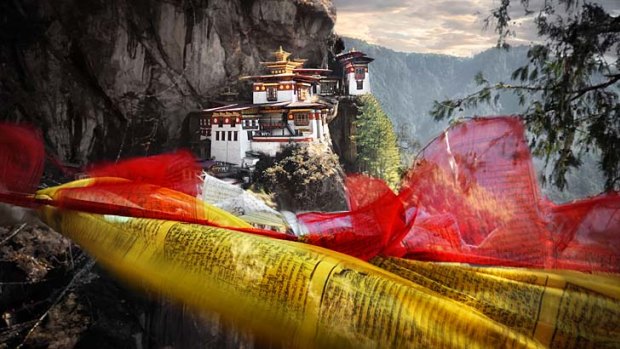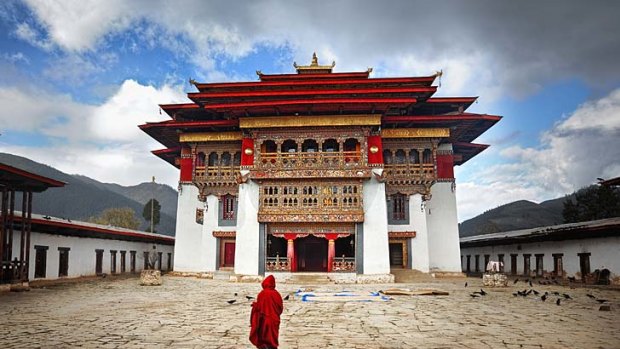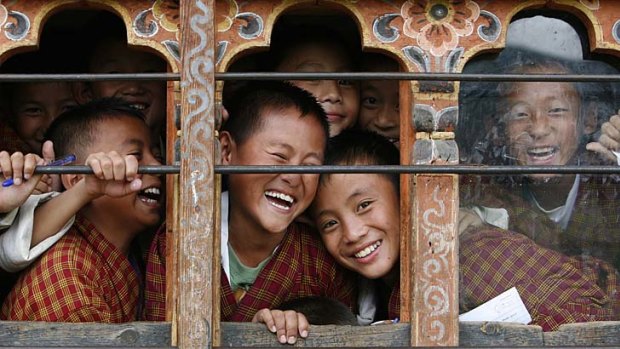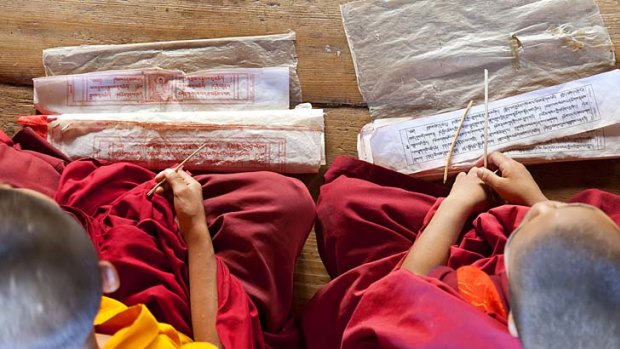The Himalayan kingdom known for its austere remoteness is embracing change. Now Buddhist shrines look down on ATMs and star-rated hotels, writes Louise Southerden.
From afar, Bhutan is a fabled kingdom, a Shangri-La on a lost horizon. If ever there was a country labouring under the weight of misconceptions and high expectations, this is it.
Not that Bhutan doesn't impress. Flying in, it's hard not to be swept off your feet. There's Mount Everest, and peak after snowy peak extending north to Tibet. Around Paro, Bhutan's second- largest city, the landscape is a fairytale of forested ranges and lush valleys dotted with farmhouses.

The spectacular Tiger's Nest monastery.Credit: Getty Images
The daydream continues when you land. The airport terminal resembles the whitewashed dzongs, or fortress-monasteries, seen all over the country. Everyone wears national dress - full-length skirts called kira for women, knee-length coat-dresses called gho for men. "Good morning, la," says our driver, Tenzin, using the honorific that makes even the simplest phrase kinder, as we board a small bus for our nine-day road trip to central Bhutan and back.
Bhutan is smaller than Switzerland, a country it's often compared to, at least geographically, but its mountainous terrain makes it seem much larger. There are remote communities accessible only by treacherous walking tracks. It can take all day to drive 200 kilometres. And Bhutan's twisting, turning roads are more than a way to get from A to B; they're a portal into the character of this Buddhist land.
We stop at roadside chortens, or small shrines, built over streams that turn prayer wheels inside; where the water flows out, drivers cup their hands to drink or wash their faces, refreshing and blessing themselves for the hairpin bends ahead. One day we pass a Buddhist verse in white paint on a rock wall. "May all sentient beings be free from wanting to be praised," it begins, but we're gone before we can read any more. And every time we cross a 3000-metre pass we shout "Hargyelo!" (Victory to the gods!), a tradition from the days when people believed it was evil spirits, not altitude, that caused dizziness and shortness of breath in high places.

One of the kingdom's remote monasteries.Credit: Getty Images
Bhutan's first roads were built in the 1960s and everywhere we go we see them being widened and resurfaced. Signs say "inconvenience regretted" and our itinerary is partly determined by opening and closing times at roadblocks that allow workers to operate excavators safely on roads barely wide enough for two vehicles to pass.
It's not just the roads that are being improved; the whole country is in the grip of change, which is remarkable considering how far Bhutan has come in the past 60 years.
Until the visionary third "dragon king" Jigme Dorji Wangchuck came to the throne in 1952, Bhutan had no schools, hospitals, postal service or currency. There was no police force or army, no electricity, no telephones, no national media - the first newspaper started in 1965, the first radio service in 1973 and Bhutan was the last country in the world to get television, in 1999.

Children at school in Thimphu.Credit: Reuters
Tourism was the last thing on anyone's mind until the coronation of the fourth king, 18-year-old Jigme Singye Wangchuck (father of the fifth and current king) in 1974. Foreign journalists were invited to attend, the first outsiders to visit Bhutan apart from a few heads of state and the occasional explorer. Bhutan's first hotels were built for them and subsequent small groups of tourists, including the first trekkers. Flights to Bhutan began in 1983, when the newly formed national airline, Drukair, began operations.
The government's "high-value, low-volume" tourism edict imposes a daily tariff on visitors to keep their numbers manageable and fund the country's developing infrastructure, at the same time branding Bhutan as an exclusive destination. It's also referred to as "high-end, low-impact" tourism because of the presence of luxury hotels run by the likes of Amanresorts, Taj and Uma, and the government's commitment to preserving the country's natural environment.
Tourism revenue has increased from about $US2 million in the late 1980s to more than $US38 million in 2008. More than 34,000 tourists visited Bhutan last year, almost four times as many as in 2004 — and that doesn't include increasing numbers of well-heeled Indians who drive across the border into Bhutan and are exempt from daily tariffs and visa fees.

Young monks studying.Credit: Getty Images
Perceptions are changing, too. "Five years ago, every email I received from a prospective client started with 'I've always wanted to go to Bhutan'," says James Irving, the director of Gold Coast-based travel company Bhutan & Beyond, which has been operating in Bhutan since 2003.
"Bhutan attracted a particular kind of person - those who were spiritually inclined, with an interest in Buddhism. Then came the travellers who had been everywhere else and wanted to add Bhutan to their list. Now, most people have heard of Bhutan, [and] it has really matured as a destination, particularly with the fifth king's wedding last October receiving so much media attention all over the world."
With Bhutan's government now making tourism a priority, the experience for travellers is being transformed, particularly in aviation. Drukair remains the only airline flying into Bhutan - partly because the mountainous terrain and weather conditions make the only international airport, in Paro, difficult for large aircraft and pilots unfamiliar with the terrain. But it operates 21 flights a week from eight cities - Bangkok, Kathmandu, Dhaka in Bangladesh, New Delhi, Kolkata and three other cities in India - and will add Singapore and Mumbai to its route map this year.
Travelling across the country from Paro, in western Bhutan, now takes half an hour instead of two days - thanks to the completion of two new airports in central and eastern Bhutan (at Bumthang and Trashigang respectively) and, in December, the introduction of domestic flights by Drukair and the newly launched Bhutan Airlines, the country's first privately owned airline. A third domestic airport, at Gelephu in southern Bhutan, which is eight hours by road from the capital, Thimphu, is under construction.
On the ground, all Bhutan's hotels were assessed and given star ratings in 2010 and, as of this year, only hotels with three stars or more can accommodate tariff-paying tourists. Tourists can now use ATMs in Thimphu and Paro to withdraw cash using international credit cards. Visas can be processed online. Tourism is expanding beyond trekking and touring to include mountain biking, cycling, whitewater rafting, kayaking and motorcycling. And customer service will improve when the first graduates emerge from Bhutan's new international-level hospitality institute, established in 2010.
A common misconception is that Bhutan is an expensive country, and this won't be helped by the increase in the daily tariff in January from $US200 to $US250 a person a night, for travel in March-May and September-November. The low season (now called the "regular" season) tariff is $US200 a night, up from $US165. But perceptions are changing here, too, Irving says. "Word is starting to get out that tariffs aren't as expensive as they first seem because they're all-inclusive [covering accommodation, meals, transport, guides and entry fees within Bhutan].
"Australians in particular are learning to understand the value and convenience of having a private guide, driver and vehicle, all of which works better in Bhutan than almost anywhere else in the world, except perhaps on safari in Africa."
Bhutan is also becoming a year-round destination. The Tourism Council of Bhutan planned to scrap the low-season tariff in July last year and although this hasn't happened yet, more travellers are opting to visit Bhutan in winter (December, January and February) and summer (June, July and August) when the daily tariff is lower than in the more popular spring and autumn months.
"As infrastructure improves and tourist numbers grow it's becoming more appealing to beat the high-season crowds by travelling in the 'regular' season when tourist numbers are so low you feel as if you have the whole kingdom to yourself," Irving says. "In winter the weather is surprisingly warm for a northern-hemisphere alpine nation, because Bhutan's deep valleys have their own microclimates. And summer is fascinating with all the villagers out planting the rice paddies; it's so green and beautiful."
Some things haven't changed, of course. There might be a four-lane highway outside Thimphu, but the white-gloved policeman still directs traffic from a small rotunda located in the middle of the city's main intersection (Bhutan still has no traffic lights).
I'd heard Bhutan described as something of a Buddhist Disneyland, but it's more level-headed and down-to-earth than that. It's still a predominantly rural Himalayan country, for one thing; most Bhutanese are subsistence farmers who live simply, sustained by Buddhism and a deep trust in the government. "We are very free, secure and safe," one young man tells me. Bhutan's kings, in particular, are widely revered. We see men wearing brooches depicting the fifth king and when I ask a government official sitting next to me on the flight from Bangkok what the king is like, he says without hesitation, "I am very proud to be one of his subjects".
Environmentally, Bhutan is streets ahead of many developed nations. The country's main source of income is the hydroelectric power it exports to India - and because Bhutan is so mountainous and its rivers flow fast naturally there's no need for man-made dams. The constitution guarantees that at least 60 per cent of the country will always be forested, and many of the country's resources remain untapped because of a decree that ecological and humanitarian considerations take precedence over economic ones.
Even its famous measure of progress, Gross National Happiness, introduced in 1972, is based on four practical "pillars": economic independence, environmental sustainability, social/cultural well-being and good governance.
Independent travel isn't allowed in Bhutan, but travelling in a group of 12, I'm pleasantly surprised at the spontaneity and flexibility we have. There's time to stand and watch monks playing an impromptu game of khuru (darts) in the garden of a dzong, and to talk to three young monks creating a sand mandala on the marble floor of a monastery. On our day-walk to the Tiger's Nest, near Paro, we share the track with other tourists, yes, but also with locals in national dress - women walking barefoot, carrying their city shoes in one hand, and men with their gho rolled down to the waist so they can walk in shirt-sleeves in the heat of the day.
A highlight of my trip is the evening we drive into Bumthang in central Bhutan; it's like watching a silent movie of Bhutanese life on the land. As the light fades and the clouds turn pink, we see people walking home carrying baskets of vegetables and cartons of eggs. Kids in our headlights wave at us. There are fires glowing and smoke curling from the roofs of the houses.
It takes us four days to reach Bumthang from Paro but we would have missed such an experience had we flown in. On the other hand, being able to fly one way and return by car will allow tourists to explore more remote parts of the country in a relatively short time and, hopefully, spread the benefits of tourism beyond the main settlements in the future.
I feel deeply charmed by Bhutan, but not in the way I'd anticipated. It's simpler, calmer and more organised than I'd expected. It is certainly changing - even more tourists will visit this year than last, many flying to destinations previously reached only by road, and they'll encounter more convenience, better service and nicer hotels than ever before - but not, if all goes well, at the expense of an authentic experience of one of the world's last special places.
Louise Southerden travelled courtesy of Peregrine Adventures, Thai Airways and Uma Paro.
FAST FACTS
Getting there
Thai Airways has a fare to Bangkok from Sydney and Melbourne (about 9hr) for about $1035 low-season return, including tax; see www.thaiairways.com. Drukair flies daily from Bangkok to Paro (4hr 40min) for about $US850 ($870) return, including tax; see . Drukair plans to fly from Singapore to Paro later this year.
Visas and tariffs Visas are required, cost $US20 and must be obtained by your tour operator before travelling. The government of Bhutan also sets a minimum daily tariff for tourists, included in the cost of your organised tour: $US250 a person a night for travel in March-May and September-November, $US200 a person a night for the other months (during winter and the rainy summer).
Part of this tariff ($US65) is a government royalty to fund education, health care and road-building in Bhutan; the remainder covers all accommodation, meals and transport, a licensed Bhutanese guide, and camping gear and porters on trekking tours.
Children under five travel free; children aged 6-12 are exempt from the royalty and pay half the adult daily tariff; students under 25 are eligible for a 25 per cent discount on the adult tariff. Independent travel is not permitted. The currency is the ngultrum or Indian rupee.
Touring there
Peregrine Adventures has a nine-day Dragon Kingdom trip that costs $2760 or $3175 a person, twin share, depending on the season. Phone 1300 791 485, see peregrineadventures.com.
Staying there
Uma Paro, a Como hotel, has 29 rooms and suites on a forested hillside overlooking Paro. Rooms cost $US290 a night for a forest-view room with breakfast, $US390 for a valley-view room, $US590 for a suite and $US690 for a one-bedroom villa.
There is also a two-bedroom villa for $US1000 a night (for up to four people). Guests don't pay the daily tariff but must pay the $US65 a person a night government royalty and a surcharge of $US30 a person a night if travelling in a group of fewer than three people.
Uma Paro's sister property, the 11-room Uma Punakha, five hours' drive east of Paro, is due to open in September. See uma.paro.como.bz.
More information
See tourism.gov.bt
Sign up for the Traveller Deals newsletter
Get exclusive travel deals delivered straight to your inbox. Sign up now.